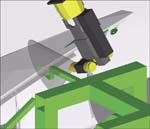Simulation Helps Overcome Paint Line Constraints
How engineers at Applied Manufacturing Technologies used software simulation to speed development of a robotic painting process for the Cadillac XLR.
The launch of any new vehicle program is never without challenges. But when Applied Manufacturing Technologies (AMT; Auburn Hills, MI) was asked to help with the design of the paint carrier for the Cadillac XLR performance car, the company faced a few more difficulties than usual.
The XLR was to be produced alongside the Chevrolet Corvette at GM’s Bowling Green, KY manufacturing facility. However, its body style was different enough from the Corvette that it would require a new carrier design for the paint line. Also, the XLR required painting of individual body panels instead of the entire car body. Space constraints, time restraints and quality demands were all issues.
Featured Content
AMT has been a supplier of integrated robotic systems consulting and engineering since 1989. For this project, the company had to rely on its expertise in mechanical design, simulation services and robot programming to develop robot paint paths that would paint the panels with a world-class finish in the most efficient manner.
“With so many factors to be considered, we knew that the best way to analyze and optimize our options was through simulation,” recalls Bret Benvenuti, AMT’s engineering group leader/paint process. “That way, we could work out any issues in the virtual world without tying up production on the plant floor.”
AMT used DELMIA’s UltraPaint simulation software for this project. The package is a physics-based, scalable robotic paint simulation and offline programming solution that lets users quickly verify the paint booth layout and painting process, then graphically program paint systems ranging from single-robot systems to multi-robot, rail tracking applications. It provides built-in robot libraries, automatic collision detection and other capabilities that DELMIA says can reduce man-hours and process engineering lead time while improving program accuracy.
Paint process-specific tools include stop station, line tracking and rail tracking; accurate downloading of paint programs to the robot systems and simulation and analysis of complex rail tracking applications to ensure that paint application is balanced evenly between all robot systems. Collision detection functionality lets users verify collision-free robot trajectories, while calibration and off-line programming and post-processing tools allow accurate off-line programming of robotic systems to minimize the impact on production schedules.
The package includes a comprehensive library of paint robot models, including the latest robots from ABB and FANUC Robotics. For FANUC systems, a visual interface that completely mimics the FANUC Line Tracking interface lets programmers use all key values, distances and error trapping logic to an off-line program using the same settings and logic that are used on the real robots. A library of paint equipment models is also available, including paint guns, door openers and workpiece fixturing hardware.
Simulation tools let users display and chart cycle times; monitor paint application parameters such as material use, fluid flow rates, gun on/off times and TCP speeds and plot 3D graphical traces of robot trajectory with interval cycle times. The software also provides paint deposition simulation and analysis tools, including multi-color contour mapping of deposited material and film gauging to measure paint thickness.
AMT engineers used the software to create a model of the robotic paint booth at Bowling Green, given the space constraints. The first issue at hand was to analyze the new carrier model. The carrier had to hold the parts securely enough to remain stationary over slopes in the conveyor and through turns in the shop, and its supports could not interfere with painting of the panels. It also had to fit through the paint oven width and be able to maneuver around the corners in the shop.
The new carrier was designed to hold all of the separate body panels in place on one carrier. This, in itself, created some challenges. There had to be enough room to paint behind the panels, and the panels needed to be spaced far enough apart so as to avoid the potential for overspray. Yet, the carrier footprint needed to be kept as small as possible given the space-constrained shop.
Next, AMT looked at cycle time. Four robots were being programmed to all spray at once over a small, compact area. This required a series of complex robotic arm motions in order to ensure that all the panels were sprayed evenly and that there were no collisions. Engineers used the package to take “snapshots” of the process, pointing out to designers where problems would occur—why a certain angle was bad, where the robot was hitting, why a certain support wouldn’t work.
Simulations revealed that the initial carrier design was going to cause interference with the paint fan, affecting quality of the paint process. Additionally, the robot applicator was hitting the carrier supports when it tried to reach all the panels. To solve these problems, the designers reworked the details of the carrier support arms.
Another problem simulation uncovered was that there was not enough room for the robots to paint all the panels when they were all stationed on one carrier. A decision was made to go to two carriers, one to hold vertical panels such as doors and fenders and one for horizontal panels including the hood, roof and deck lid. This configuration allowed the panels to be spaced further apart, yet still met the required production rate. In fact, the simulation showed that painting was being accomplished 60 seconds under the required cycle time.
Once the process changes were verified in UltraPaint, engineers downloaded programs directly to the robots in the paint shop. The actual programs ran so close to the simulation that very little program touchup was required.
“By simulating the XLR line in UltraPaint, I believe we saved four months as compared to the old way of designing paint processes,” says Benvenuti. “Plus, the ability to program the robots offline easily saved another two weeks as compared to doing it on the floor.”
Dassault Systemes





















